Many different kinds of dinosaurs evolved over the long 150 million year reign of the dinosaurs (figure 45.59). While each kind of dinosaur has its own peculiarities, many can be thought of as variants of one of six basic body designs: sauropods, theropods, stegosaurs, ornithopods, armored dinosaurs, and horned dinosaurs (figure 45.60). Each body design is driven by the requirements of a particular life-style, determined in large measure by what the dinosaur ate, how it digested its meal, and how it avoided being eaten.

Figure 45.59
A dinosaur cladogram.

Figure 45.60
Dinosaurs are categorized into two main groups based on hip design.
Sauropods
Sauropods, the dominant dinosaurs of the Jurassic, were giant herbivores, the largest land animals to have ever lived. All had massive barrel-shaped bodies supported by four pillar-like legs, and very long necks and tails. There were two basic kinds.

| Backbone Design. The secret of supporting the massive sauropod body lay in the construction of the backbone. Great chunks of bone were hollowed out from the sides of each vertebra, leaving a backbone made of thin sheets and struts of bone, lightweight but immensely strong. | |
| Neck Design. Sauropods have extremely long necks, as much as half their length. These 35-foot necks did not have more vertebrae than other dinosaurs (typically 12; for comparison, your neck has nine), but each was elongated to three times the length of a back vertebra. While some sauropods may have fed on treetops, many ate low vegetation, and it is not clear why they had such long necks. How did the neck muscles support this 35-ton weight? They didn’t. Front and back legs act like the towers of a suspension bridge. A groove runs along the top of the backbone, holding a massive tendon that runs like a cable between tail and neck. The cable allows the weight of the long neck to be supported by a counterbalancing tail—you get the same effect if you hold your arms outstretched from your sides, a rope passing tautly from one wrist to the other over your shoulders—your arm muscles don’t have to work to keep your arms up, because their weight is going down your shoulders to your legs. | |
| Heart Design. If Brachiosaurus stood with its head up, its brain would be 25 feet higher than it heart. The weight of a column of blood this tall would produce enormous pressure in the heart. If it were a typical reptile heart, with an incomplete division of the ventricle, blood would push into the pulmonary circuit and blow out the thin-walled capillaries of the lungs. This argues that sauropods must have had four-chambered hearts, like modern birds and mammals do, with a complete separation of the ventricle. | |
| Stomach Design. Sauropods were vegetarians that fed on cycads, palm-like plants with mushy interiors. They shredded the plants with thin spoon-shaped or pencil-like teeth, and ate the shreds without grinding. The grinding necessary to prepare the plant material for digestion took place within the stomach, in a gizzard where stones swallowed by the dinosaur mashed the plant material to a pulp. The cellulose plant material was then digested by microbes within stomachs that acted as huge digestion vats. The bigger the stomach and its rocks, the more efficient the grinding, which is one reason the sauropods grew so large. | |
| Leg Design. Sauropods were lizard-hipped. The immense weight of the body was supported by four pillar-like legs that did not bend when walking. Each leg ended with a broad, round “elephant-like” foot. Like all dinosaurs, sauropods stood on their toes—a wedge-shaped heel pad supported the great weight. | |
| Tail Design. Their tracks tell us that sauropods did not drag their tails along the ground, but rather held them stiffly out behind. This, and the fact that the neck bones of most sauropods butt up against each other squarely, suggests to many paleontologists that sauropods held their necks out straight, rather than “up” as often illustrated. |
Top-Eaters
Typified by this Brachiosaurus, these largest of sauropods had serrated, chopping teeth and front legs longer than the rear ones, to raise the body up to crop the tops of trees. A Brachiosaurus was 75 feet long and 40 feet tall (the shoulders were 20 feet off the ground!), weighing an incredible 89 tons (more than 12 African bull elephants or three thousand students). The neck was 32 feet long!
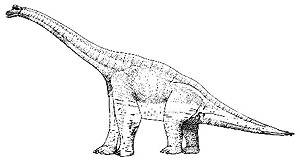
Bottom-Browsers
Typified by this Diplodocus, these sauropods had smaller bodies than the top-eaters (Diplodocus weighed 11 tons), and even longer necks and tails (the tail of Diplodocus is 46 feet long!). From tip of nose to tip of tail, Diplodocus was 86 feet long, the length of a subway train. Other bottom browsers were even longer. Opposite of top eaters, the hind legs of bottom browsers were longer than the front legs. They had slender, peg-like teeth, good for browsing at the surface. Apatosaurus was a somewhat larger member of this group, weighing 33 tons.

Theropods
Theropods were bipedal meat-eaters with short grasping forearms and sharp slicing teeth. All theropods were lizard-hipped, and shared the same basic body design. There were three basic kinds, differing mostly in size.
Carnosaurs
Large theropods—typified by Allosaurus in the Jurassic and this Tyrannosaurus rex (the largest of all meat-eating dinosaurs) in the Cretaceous. Allosaurus,the chief carnivore of the Jurassic, weighed about 2 tons and stood some 15 feet tall, while Tyrannosaurus (which evolved late in the Cretaceous and was never common) weighed fully 8 tons and stood 20 feet tall, with sharp ripping teeth each 6 inches long.

Raptors
Medium-sized theropods with a lethal 5″ sickle-shaped claw on each foot for ripping prey. About the size of a human, they had the light speedy body of a coelurosaur with the massive strong head of a carnosaur—typified by Velociraptor and this Deinonychus. Cretaceous dinosaurs, raptors had among the largest brains for body weight of any dinosaur. The arms were long for a theropod, with three grasping fingers with long sharp claws.

Coelurosaurs
Small, fast running descendants of Coelophysis, with long necks and hollow, delicate bones, built for speed. Typified by this chicken-sized (8 pound)Compsognathus, coelurosaurs often hunted in packs.
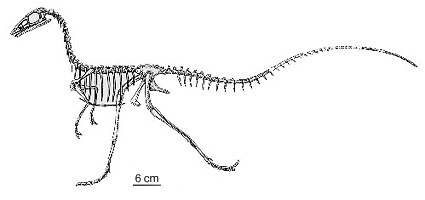
Common in the late Jurassic, they are thought to be the direct ancestors of birds.

| Tooth design. Theropod teeth are very different from a lion or wolf, which have deep-penetrating fangs. Theropods have long rows of curving dagger-like teeth, designed to slash through flesh, not hold it. Prey are literally sliced open: each tooth has a blunt front and a tapered sharp trailing edge. Their backward curve drives the line of teeth into a wound, slashing it open as the teeth saw backwards, while the blunt fronts stops forward movement of the teeth and so prevents struggling prey from wriggling free. | |
| Jaw Design. The largest teeth are the upper ones, on the skull. During a bite, the jaw teeth hold the prey while the skull is pulled down and back by the neck. The jaw joint allows the skull to slide, shifting aft during a bite, so that retracting the powerful neck muscles after a bite pulls the skull back, raking the upper teeth backward through the prey. The jaw joints of theropods are quite flexible, allowing a very large bite. The lower jaw is hinged in the middle and at the center. In Cretaceous carnosaurs like T. rex, the skull is solid and the jaw moves in a grove along the skull. In Jurassic carnosaurs like Allosaurus, the jaw joint is like that of a teleost fish, connecting the jaw to the skull with a strut of bone—when the strut swings outward, it splays the jaw to the sides, creating a huge bite. | |
| Leg Design. Theropods are bipedal, with short forearms and long powerful hind legs. The forelimbs of most theropods have 3 sharp claws (or in the case of T. rex, two) for seizing prey. | |
| Tail Design. All theropods had long tails to counterbalance the weight of the body forward of the hips, giving them great agility. Tails of many theropods were stiffened by bony rods which ensheath the tail bones—this extra support is necessary to withstand the whiplash forces put upon the tail by powerful movements of the neck. | |
| Backbone Design. In order to pivot their body weight directly over the hips, the vertebrae where the hip bones attach are fused into a strong rigid beam. The rigid backbone is balanced by an interlocking array of bone and muscle running down the front of the body from shoulder to lower hip. Called “belly ribs”, this bodice of bone acted as an effective shield to protect the belly. | |
| Skull Design. The skull of Jurassic theropods is not a solid cranium, like a lion or bear, but a highly flexible “rod and sheet” construction—struts, ball-in-socket joints, and sliding articulations, all bound together with ligaments. The braincase is the strong central core of the skull, only loosely bound to the other parts. In Cretaceous theropods, the skull is more solidly constructed, culminating in the T. rex skull, a single massive structure of bone. |
Ornithopods
Ornithopods were large bipedal herbivores, one of several kinds of “chewing” plant-eaters dominated the Cretaceous period. Like stegosaurs, the ornithopods were bird-hipped. The great innovation of the ornithopods, which led to their replacing sauropods and stegosaurs, was the invention of chewing teeth. Unlike other herbivores of the Cretaceous, ornithopods lack any obvious defense against theropods. They must have had them, but their nature is unknown—perhaps they sprayed awful-smelling perfumes on their enemies, like a skunk! The two most important kinds of ornithopods were:
Iguanodonts
Iguanodonts, typified by this Iguanodon, were very large herbivores, 30 ft long, 16 feet tall, and weighing 5 tons—as big as a small house! Iguanodon had massive legs, and walked on all four legs most of the time. They evolved in the mid-Jurassic, replacing sauropods, and were common until replaced in turn by another kind of ornithopod, the hadrosaur.
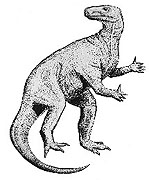
Hadrosaurs
Hadrosaurs, a very successful dinosaur typified by this Hadrosaurus, are often called duck-billed dinosaurs because they had a broad, flattened snout with a toothless beak used to crop plants. Thirty feet long, but less massive than iguanodonts, hadrosaurs had long hind legs—they walked on four legs, but were able to rise up and run on their hind legs like an ostrich in times of danger.
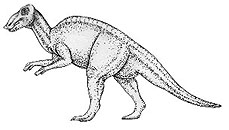
Many had bony crests on the tops of their heads, which may have been used as trumpets. In the Cretaceous, hadrosaurs were the most abundant dinosaurs in North America.
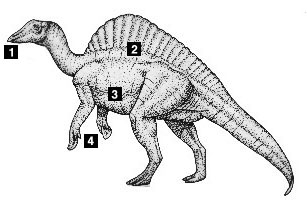
| Mouth Design. Both iguanodonts and hadrosaurs had beaks in the front of the mouth for cropping plants, with a sharp, horny edge—like a turtle. There were large batteries of hundreds of grinding teeth on each side of the mouth—more teeth than any other dinosaur. At any moment, rows of young teeth are growing into the mouth, replacing worn-out teeth. The grinding surface is perhaps the most effective that has ever evolved, far superior to today’s mammal herbivores. Unlike theropods or sauropods, ornithopods had cheeks! This was a necessary adaptation for retaining plant material in the mouth while chewing it. | |
| Backbone Design. The bipedal posture of ornithopods presents exactly the same requirements for strengthening the backbone as we encountered in designing a theropod, but here the solution is quite different. Theropods have large muscles on either side of the spine to strengthen and stiffen the back, but in ornithopods these muscles became modified into long, bony ossified tendons, a latticework of long rods which provide more support for much less weight. Running from mid-back to mid-tail, this bony supporting sheath acts like a stiff girdle. The backbone of many ornithopods bent down sharply at the shoulder, locating the head low-to-the-ground when on all fours. | |
| Stomach Design. The belly of plant eaters needs to be large, as plant material takes a considerable time to digest. In ornithopods, the bone that in lizard-hipped sauropods and therapods faces forward (the pubis bone) is rotated backward parallel to the bone at the back. This leaves a great deal more space for the belly, which is now free to extend back between the legs. Not only can the belly be larger, this shift also repositions the weight of the stomach back between the legs, allowing an upright posture. Without it, such a large-bellied animal would be obliged to walk on all fours. | |
| Hand Design. In iguanodonts, hadrosaurs, and other large bipedal ornithopods, the toes on the front feet end in small rounded hooves, permitting them to walk on all fours occasionally. The thumb was modified as a spike for defense, while the little finger was able to bend inward—a grasping finger! |
Armored Dinosaurs
Plant-eating dinosaurs of the Cretaceous, these bird-hipped dinosaurs were designed like battle tanks. Individuals weighed up to 3 tons, their bodies encased in heavy armor. The armor consisted of bands of horn-covered plates embedded in the skin from neck to tip of tail, with sharp spikes sticking out from each side of the body. Armored dinosaurs were among the most diverse of all dinosaurs. There were two basic kinds:
Nodosaurs
From 6 to over 25 feet long, these dinosaurs had hundreds of “nodes” of bone studding their bony plates like thorns (hence their name). Their small heads were long and slender. Nodosaurs were large, such as this Nodosaurus, 18 ft long. Sauropelta was 25 feet long and estimated to have weighed over three tons. Weighing this much, they could not have moved fast—their shoulders and hips were powerfully developed to lumber along under their great weight. Most nodosaurs cropped plants with a turtle-like beak in front, and had weak teeth on the side of the jaw.
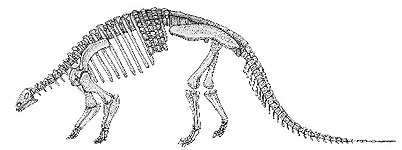
Ankylosaurs
Replacing nodosaurs in the late Cretaceous, these armored herbivores had a unique defensive weapon at the tip of their tails—a large ball of fused bone that was swung from side to side as a club. Like a bowling ball on a chain (only even heavier), it could smash a theropod lethally. Bigger than nodosaurs, ankylosaurs were shorter and stockier—typified by this Ankylosaurus, which was fully 33 feet long and weighed 4 tons, its broad squat body supported by strong stumpy legs set directly beneath the body. Ankylosaurs had hips fused to the backbone, forming a super-strong anchor for the hind legs.
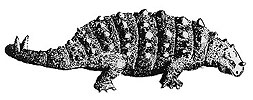
Stegosaurs
Stegosaurs were large plant-eating dinosaurs of the Jurassic. They had small heads and a row of great bony plates that extended down the backbone, projecting alternately to one side, then the other (many pictures erroneously portray them as having two rows of plates!). The bony plates may have been useful in defense, but appear to have functioned primarily as a heating and cooling system—blood flowed through the thin epithelium covering the plates and was either cooled by breezes or warmed by the sun. Defense was provided by three-foot-long sharp spikes on the tail, used to whack any threatening predators. Unlike sauropods and theropods, stegosaurs were bird-hipped.
Stegosaurs
All 24 kinds of stegosaurs are basically similar, typified by Stegosaurus, the largest: Stegosaurus had four spikes on the tip of its tail, while other stegosaurs had 8 or more. On average, Stegosaurus was 20 ft long and weighed 2 tons. Much too heavy to stand upright, stegosaurs walked on four legs. The massive hind legs were twice the length of the forelegs, which meant that the body sloped steeply forward from the hips. The skull was only 16 inches long, containing a brain the size of a walnut. It had a toothless beak in front for cropping cycads, and tiny non-abrading teeth on the sides—like sauropods, it crushed plant material with stones in its stomach.
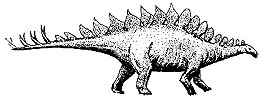
Horned Dinosaurs
The ceratopians or “horned dinosaurs” were the last group of bird-hipped dinosaurs to evolve, late in the Cretaceous, only 20 million years before all dinosaurs became extinct. In this short time they spread all over the world, a very successful group. Unlike the armored dinosaurs, the defensive armor of horned dinosaurs was confined to their heads, which sported a bony cape and long sharp horns. Like all bird-hipped dinosaurs, horned dinosaurs were plant-eaters, with sharp beaks for cropping vegetation and particularly effective batteries of grinding teeth (the individual teeth had multiple roots like your molars do, allowing a very strong bite). Typified by this Chamasaurus and by Triceratops, horned dinosaurs were built like bulldozers, powerful and low to the ground—and they were BIG:
Ceratopians
A typical Triceratops individual was over 30 feet long and weighed as much as 11 tons. Its neck frill is a solid sheet of bone, bearing needle-sharp horns over 3 feet long. With stocky but powerful legs, it could run quite fast—imagine those horns bearing down on you like a freight train!
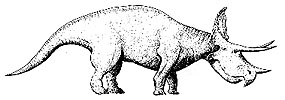
Chapter Summary
45.5 The dinosaurs were the dominant terrestrial vertebrates until they abruptly disappeared 65 million years ago.
- Dinosaurs, crocodiles, and birds are all archosaurs.
- Early dinosaurs are distinguished from other forms of early reptiles because their legs were positioned under the body. This allowed for swift movement and capture of prey.
- Jurassic dinosaurs include the giant sauropods, the stegosaurs, and carnivorous dinosaurs called theropods.
- With the evolution of angiosperms, dinosaurs that had chewing teeth became the dominant herbivores in the Cretaceous Period. Also, theropods became more diverse in the Cretaceous.
- The impact of a meteor likely caused the abrupt extinction of the dinosaurs 65 million years ago. Atmospheric debris created by the impact would have blocked sunlight and caused global temperatures to drop. In this cold, dinosaurs would not be able to survive because the had no body insulation.
45.6 Dinosaurs had a variety of unique skeletal and physiological characteristics.
- Four types of skull design exist among reptiles: anapsid, synapsid, euryapsid, and diapsid. Crocodiles and dinosaurs have diapsid skulls, with two holes between the postorbital and squamosal bones.
- Dinosaurs have simple hinge knees and ankles that provide the strength and stability needed for an upright stance.
- Fossil evidence in many dinosaurs indicates that their young grew fast, their bones had an abundance of Haversian canals and a loose array of collagen, and they had similar amounts of an oxygen isotope in their torso and extremity bones. These are all characteristics seen in modern-day endotherms (mammals and birds), suggesting that many dinosaurs may have been endothermic.
45.7 Dinosaurs can be categorized into six basic body designs.
- Sauropods had long necks and tails, large bodies, and four pillar-like legs. They were herbivorous and likely had a four-chambered heart, had a large stomach for grinding up plant material, and held their tail and neck straight out during locomotion.
- Theropods were carnivorous, with large-biting jaws and teeth able to slash through prey. Special backbone, tail, and leg designs allowed theropods to be bipedal.
- The chewing teeth of ornithopods allowed them to be more efficient herbivores than the sauropods and stegosaurs. Ornithopods were bipedal but could also walk on all fours.
- Three other types of ornithischians each had unique, defensive structures.
Key Concepts
- Thecodonts. Early reptiles called thecodonts were crocodile-like carnivorous reptiles that lived during the Triassic Period. Dinosaurs, birds, and crocodiles evolved from them.
- Endothermy and ectothermy. Endothermic animals are able to control their body temperature using their own metabolic processes, while ectothermic animals must use the environment to control their body temperature.
- Saurischians and ornithischians. Dinosaurs are divided into two main groups based on their hip design. In saurischians, the three hip bones have a three-pronged design and extend out in different directions. In ornithischians, two of the bones extend in the same plane parallel to each other.
Review Questions
- How long did dinosaurs live, how did they originate, and do they have living descendants?
- Which group of early reptiles gave rise to dinosaurs, birds, and crocodiles?
- What key dinosaurian characteristics does Eoraptor exhibit?
- How did the way stegosaurs ate differ from the way iguanodonts ate?
- What kind of evidence supports the hypothesis that the impact of a meteorite caused the extinction of the dinosaurs?
- Why are crocodiles not considered dinosaurs?
- Describe the fossil evidence indicating that some dinosaurs may have exhibited parental care similar to that seen among birds.
- What special backbone and neck design did sauropods have that allowed them to support their massive bodies?
- Which group of dinosaurs is characterized by terrestrial flesh-eaters?
- How did the ways ornithopods achieved bipedalism differ from the way theropods achieved it?
- What might have been the function of the bony plates that extended along the backbone of stegosaurs?
Thought Questions
- Flying reptiles were a very diverse group during the age of dinosaurs. However, although the present age might be considered the age of mammals, bats (the only flying mammals) exhibit far less diversity than did flying reptiles. Can you suggest as explanation for this?
- If you were presented with a complete skeleton of a small reptile from the late Triassic, what one feature could you use to establish if the fossil is a dinosaur or a thecodont?
Internet Links
Dinosauricon
An outstanding site featuring a complete listing of dinosaur clades, dinosaur record breakers, excellent diagrams illustrating key points of anatomy, information on “non-dinosaurs,” and many other rich resources.
DinoBuzz
Detailed information and discussion of many current topics concerning dinosaurs, such as dinosaur-bird relationships, warm blooded dinosaurs, dinosaur extinction, and many other topics.
Teaching About Dinosaurs
A broad array of lesson plans and activities about dinosaurs, both online and offline, with many interesting links.
For Further Reading
Bakker, R. T.: The Dinosaur Heresies, Kensington Publishing Company, New York, 1986.
Benton, M.: The Dinosaur Encyclopedia, Simon & Schuster, New York, 1984.
Cobb, V.: The Monster Who Died, Coward-McCann, Inc., New York, 1983.
Czerkas, S. J. and E. C. Olson, eds: Dinosaurs Past and Present Volume I, The University of Washington Press, Seattle, 1987.
Dixon, D., B. Cox, R. J. G. Savage, and B. Gardiner: The Macmillan Illustrated Encyclopedia of Dinosaurs and Prehistoric Animals, Macmillan, New York, 1988.
Fastovsky, D. E. and D. B. Weishampel: The Evolution and Extinction of the Dinosaurs, Cambridge University Press, New York, 1996.
Gore, R.: “Dinosaurs,” National Geographic, January 1993, vol. 183(1), pages 2-53.
Horner, J. R.: Digging Dinosaurs, Harper & Row Publishers, New York, 1988
Horner, J. R. and Lessem, D: The Complete T. rex, Simon & Schuster, New York, 1993.
Lambert, D.: A Field Guide to Dinosaurs, Avon Books, New York, 1983.
Lambert, D.: The Field Guide to Prehistoric Life, Facts on File, Inc., New York, 1985.
Lessem, D.: Kings of Creation, Simon & Schuster, New York, 1992.
Norman, D.: Dinosaur!, Prentice Hall, New York, 1991.
Norman, D: Prehistoric Life: The Rise of the Vertebrates, Macmillan, New York, 1994.
Psihoyos, L.: Hunting Dinosaurs, Random House, New York, 1994.
Raup, D. M: Extinction: Bad Genes or Bad Luck? W. W. Norton & Company, New York, 1991.
Raup, D. M.: The Nemesis Affair, W. W. Norton & Company, New York, 1986.
Russell, D. A.: An Odyssey in Time: The Dinosaurs of North America, University of Toronto Press and National Museum of Natural Sciences, Canada, 1989.
Spalding, D. A. E.: Dinosaur Hunters, Prima Publishing, Rocklin, CA, 1993.